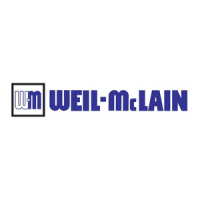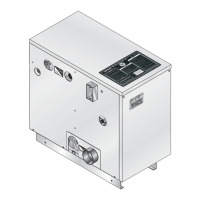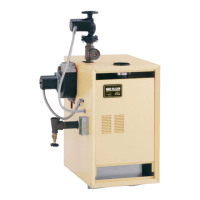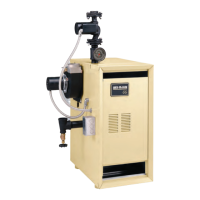


Do you have a question about the Weil-McLain GV90+ and is the answer not in the manual?
Important safety warnings for installers and users regarding boiler operation and maintenance.
Guidelines for installing the boiler at higher altitudes, including component adjustments.
Recommended minimum clearances around the boiler for proper service access.
Table detailing recommended condensate pump capacities for GV90+ boilers.
Instructions for filling the boiler system and connecting the water supply for testing.
Procedure for draining the system and removing necessary fittings after testing.
Information on installing an air separator in the piping system.
Guidelines for correctly installing the relief valve.
Method for simplifying pipe and circulator sizing for residential applications.
Instructions for manually adjusting supply water temperature using balancing valves.
Application of outdoor reset control systems for supply water temperature regulation.
Guidelines for locating and spacing multiple boilers in a boiler room.
Methods for controlling multiple GV90+ boilers using a boiler control/sequencing system.
Recommendations for piping multiple GV90+ boilers in primary/secondary circuits.
Details on installing Easy-Fit® manifolds for multiple boiler water piping.
Procedure for testing existing vent systems when replacing a boiler.
Instructions for direct vent installations, including air openings.
Instructions for direct exhaust installations, including air openings.
Guidance on calculating the required cross-sectional area for combined air ducts.
Required air opening sizes for direct vent installations with and without other appliances.
Guidelines for terminating vent and air connections for multiple boilers.
Instructions for installing concentric sidewall vent terminations.
Details on preparing and installing termination fittings for vertical venting.
Steps for mounting the concentric vent termination assembly at the roof penetration.
Connecting vent and air piping for direct exhaust and direct vent systems.
Details on tight construction, exhaust fans, and motorized dampers affecting air openings.
Options for sidewall termination of direct exhaust vent piping.
Procedures for connecting the gas supply piping to the boiler.
Diagrams and instructions for making power and thermostat wiring connections.
Guidance on wiring additional limit controls if used.
Instructions for installing and wiring thermostats.
Wiring for DHW, R&C connections, multiple zones, and CO detectors.
Guidelines to prevent personal injury or damage when using freeze protection fluids.
Procedure for flushing the system to remove sediment before filling.
Requirements for maintaining proper water chemistry in the boiler system.
Information on using antifreeze products approved for GV90+ boilers.
Setting the boiler operating temperature using the control knob.
Adjusting the economy setting for time delay to save energy.
Procedure for connecting a manometer to adjust gas valve outlet pressure at high altitudes.
Tasks to be performed by a qualified service technician during annual start-up.
Maintenance tasks for the owner to perform annually.
Routine checks including boiler area, piping, and controls.
Emphasizes annual inspection and start-up by a qualified technician.
Detailed inspection procedures for boiler components and systems.
Verify combustion and ventilation air openings are unobstructed.
Visually inspect flue gas venting and combustion air piping for issues.
Procedure for removing the blower housing for cleaning.
Steps for cleaning boiler heating surfaces using water spray.
Preparation steps and tools needed before starting troubleshooting.
Explanation of IBC indicator lights indicating lockout conditions.
Explanation of IBC indicator lights indicating non-lockout operating modes.
Certificate to be completed upon installation for record-keeping.
Diagram illustrating the physical dimensions of the boiler.
Important safety warnings for installers and users regarding boiler operation and maintenance.
Guidelines for installing the boiler at higher altitudes, including component adjustments.
Recommended minimum clearances around the boiler for proper service access.
Table detailing recommended condensate pump capacities for GV90+ boilers.
Instructions for filling the boiler system and connecting the water supply for testing.
Procedure for draining the system and removing necessary fittings after testing.
Information on installing an air separator in the piping system.
Guidelines for correctly installing the relief valve.
Method for simplifying pipe and circulator sizing for residential applications.
Instructions for manually adjusting supply water temperature using balancing valves.
Application of outdoor reset control systems for supply water temperature regulation.
Guidelines for locating and spacing multiple boilers in a boiler room.
Methods for controlling multiple GV90+ boilers using a boiler control/sequencing system.
Recommendations for piping multiple GV90+ boilers in primary/secondary circuits.
Details on installing Easy-Fit® manifolds for multiple boiler water piping.
Procedure for testing existing vent systems when replacing a boiler.
Instructions for direct vent installations, including air openings.
Instructions for direct exhaust installations, including air openings.
Guidance on calculating the required cross-sectional area for combined air ducts.
Required air opening sizes for direct vent installations with and without other appliances.
Guidelines for terminating vent and air connections for multiple boilers.
Instructions for installing concentric sidewall vent terminations.
Details on preparing and installing termination fittings for vertical venting.
Steps for mounting the concentric vent termination assembly at the roof penetration.
Connecting vent and air piping for direct exhaust and direct vent systems.
Details on tight construction, exhaust fans, and motorized dampers affecting air openings.
Options for sidewall termination of direct exhaust vent piping.
Procedures for connecting the gas supply piping to the boiler.
Diagrams and instructions for making power and thermostat wiring connections.
Guidance on wiring additional limit controls if used.
Instructions for installing and wiring thermostats.
Wiring for DHW, R&C connections, multiple zones, and CO detectors.
Guidelines to prevent personal injury or damage when using freeze protection fluids.
Procedure for flushing the system to remove sediment before filling.
Requirements for maintaining proper water chemistry in the boiler system.
Information on using antifreeze products approved for GV90+ boilers.
Setting the boiler operating temperature using the control knob.
Adjusting the economy setting for time delay to save energy.
Procedure for connecting a manometer to adjust gas valve outlet pressure at high altitudes.
Tasks to be performed by a qualified service technician during annual start-up.
Maintenance tasks for the owner to perform annually.
Routine checks including boiler area, piping, and controls.
Emphasizes annual inspection and start-up by a qualified technician.
Detailed inspection procedures for boiler components and systems.
Verify combustion and ventilation air openings are unobstructed.
Visually inspect flue gas venting and combustion air piping for issues.
Procedure for removing the blower housing for cleaning.
Steps for cleaning boiler heating surfaces using water spray.
Preparation steps and tools needed before starting troubleshooting.
Explanation of IBC indicator lights indicating lockout conditions.
Explanation of IBC indicator lights indicating non-lockout operating modes.
Certificate to be completed upon installation for record-keeping.
Diagram illustrating the physical dimensions of the boiler.
| Brand | Weil-McLain |
|---|---|
| Model | GV90+ |
| Category | Boiler |
| Language | English |












